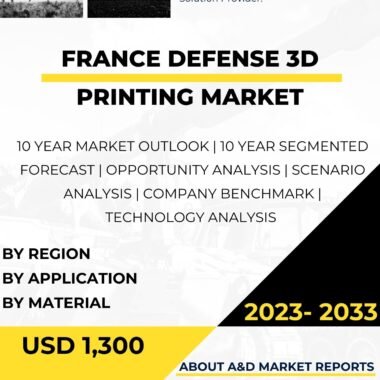Description
The Brazil defense 3D printing market is a rapidly expanding and transformative sector that has the potential to revolutionize the country’s defense industry. 3D printing, also known as additive manufacturing, is a cutting-edge technology that allows the creation of three-dimensional objects layer by layer, using digital design files. This innovative approach to manufacturing offers numerous advantages, including reduced production times, cost-effectiveness, design flexibility, and the ability to create complex geometries and customized components. As Brazil seeks to modernize its armed forces and enhance its defense capabilities, 3D printing has emerged as a key enabler, driving advancements across various defense applications.
One of the primary areas where 3D printing has made a significant impact is in the production of spare parts and components for defense equipment. The Brazilian military operates a diverse range of equipment, including aircraft, naval vessels, armored vehicles, and infantry weapons. The maintenance and repair of these systems often require access to specific spare parts, some of which may be outdated, rare, or expensive to procure through traditional supply chains. 3D printing enables the on-demand production of these spare parts, reducing lead times and costs while ensuring the operational readiness of critical defense assets.
Moreover, 3D printing empowers the defense industry to design and manufacture complex and lightweight components that were previously challenging or impossible to produce using conventional methods. By optimizing the design of components through topology optimization and generative design techniques, Brazil can create lightweight yet robust parts that enhance the performance and fuel efficiency of military platforms. This advancement is particularly relevant for aircraft and armored vehicles, where weight reduction directly translates to increased range, payload capacity, and operational flexibility.
In addition to its impact on traditional defense platforms, 3D printing has also been leveraged for the development of cutting-edge technologies, such as drones and unmanned systems. The design freedom offered by additive manufacturing allows for the creation of novel drone configurations that improve aerodynamics and increase stealth capabilities. Brazil’s investment in the development of indigenous drone technologies and associated components using 3D printing positions the country as a competitive player in the global unmanned systems market.
Furthermore, the adoption of 3D printing in the defense sector has opened doors for increased collaboration between the military, research institutions, and the private sector. Brazilian universities and technology companies have been actively engaged in research and development initiatives to explore new applications of 3D printing in defense. This collaboration has not only contributed to advancements in the technology itself but has also fostered local expertise and capabilities in additive manufacturing.
Beyond hardware production, 3D printing has demonstrated potential in the fabrication of advanced materials for defense applications. The ability to create complex lattice structures and gradient materials allows for the development of new composites and materials with superior mechanical properties. These advanced materials can be used in armor systems, aircraft components, and even in medical applications for wounded soldiers.
In line with its commitment to fostering domestic innovation, the Brazilian government has taken steps to support the growth of the defense 3D printing market. Financial incentives, research grants, and collaborative partnerships between defense agencies and private enterprises have facilitated the integration of 3D printing technologies into the country’s defense manufacturing ecosystem.
However, the Brazil defense 3D printing market also faces certain challenges. The high cost of 3D printing equipment and materials can pose initial barriers to entry, particularly for smaller companies or research institutions. Additionally, ensuring the security and intellectual property protection of 3D printing technologies and defense designs is critical, given the sensitive nature of defense applications. Strict controls and cybersecurity measures must be in place to safeguard critical information and prevent unauthorized access.
In conclusion, the Brazil defense 3D printing market is a rapidly growing and transformative sector that offers significant potential for enhancing the country’s defense capabilities. The adoption of 3D printing technology in defense manufacturing enables cost-effective, rapid, and customizable production of spare parts, components, and advanced materials. As Brazil seeks to modernize its armed forces, the versatility and design freedom offered by additive manufacturing will play a pivotal role in developing cutting-edge defense platforms and technologies. Through strategic partnerships, research and development initiatives, and continued government support, the Brazil defense 3D printing market is poised for continued growth, contributing to the nation’s security and technological advancement in the global defense landscape.




